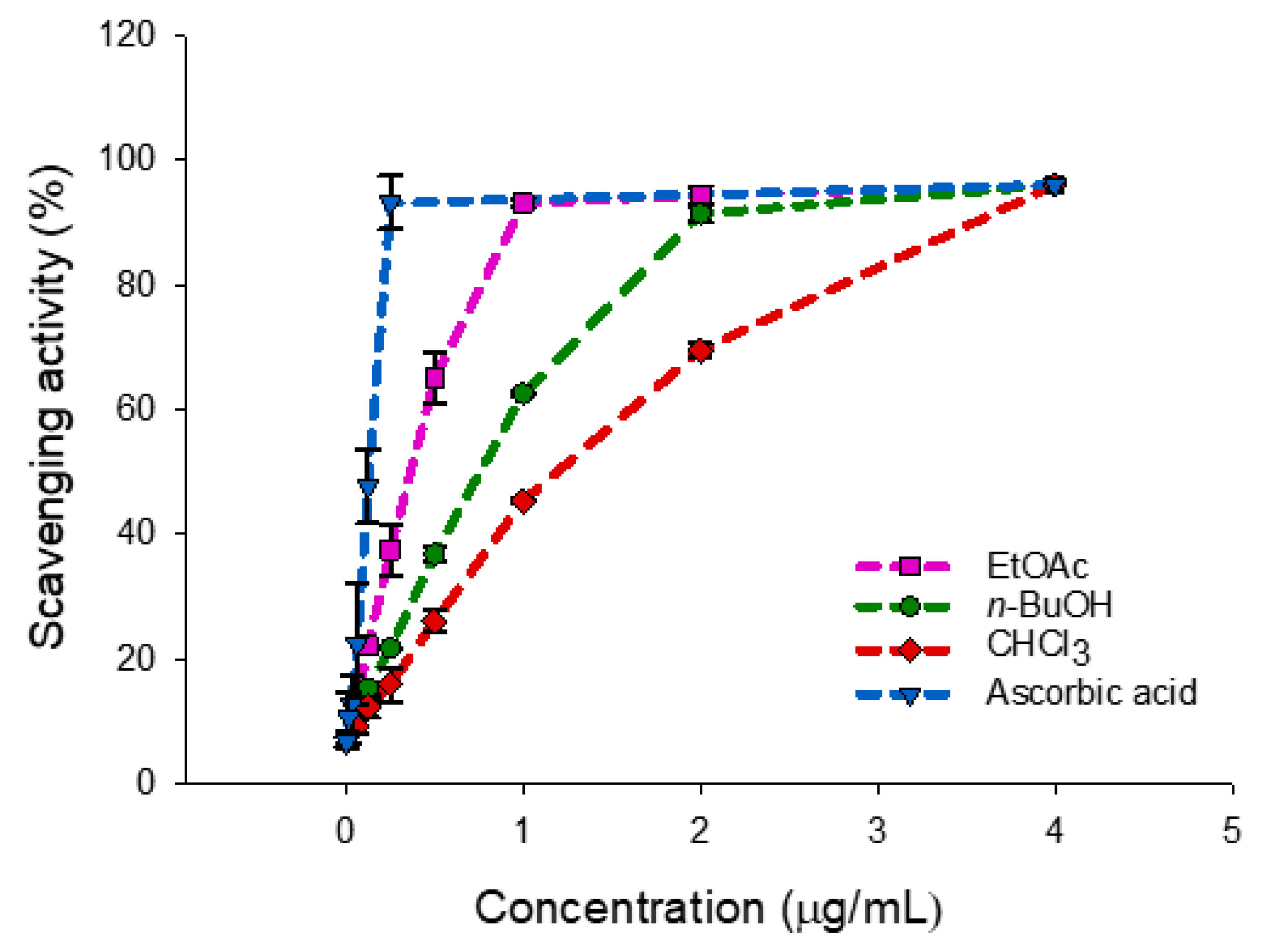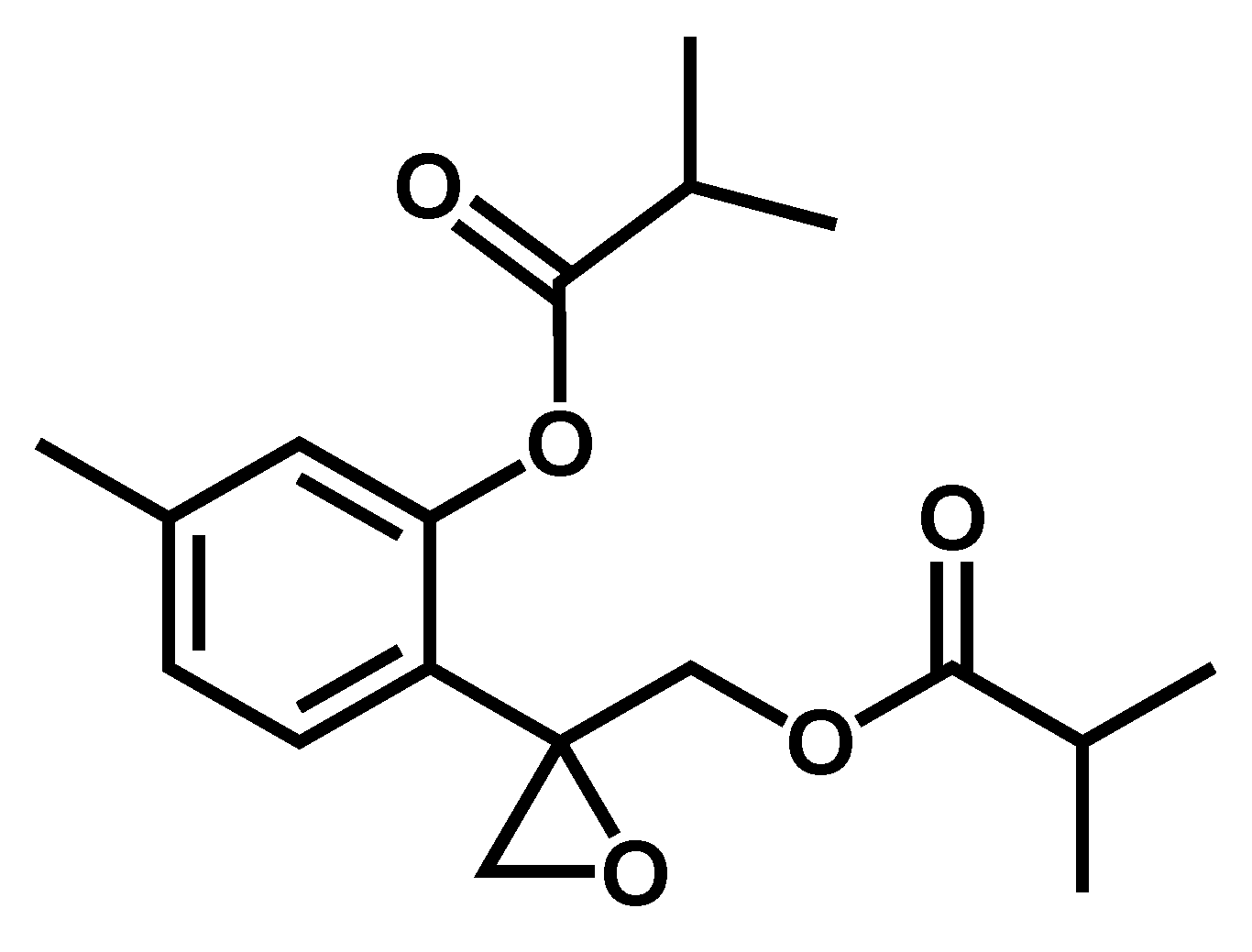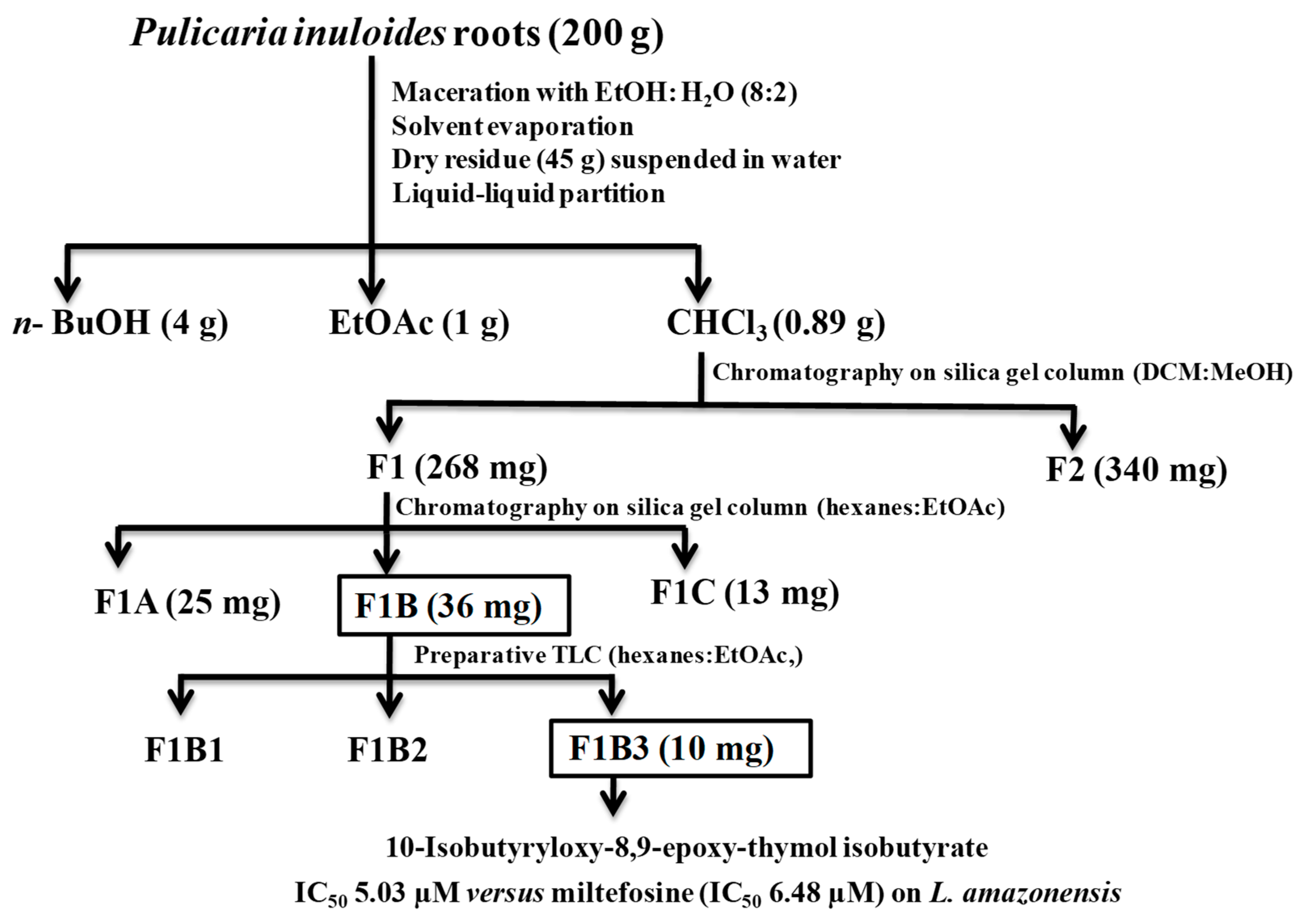Antioxidant and Leishmanicidal Evaluation of Pulicaria Inuloides Root Extracts: A Bioguided Fractionation
Abstract
:1. Introduction
2. Results and Discussion
2.1. DPPH Radical Scavenging Activity
2.2. Total Phenolic and Flavonoids Contents of Extracts
2.3. Bioassay-Guided Fractionation
3. Materials and Methods
3.1. General Experimental Procedure
3.2. Plant Material and Extraction
3.3. DPPH Radical Scavenging Assay
3.4. Determination of Total Phenolic Content
3.5. Determination of Total Flavonoid Content
3.6. Parasite Strains
3.7. In Vitro Effect on Promastigote Forms of Leishmania spp
3.8. In Vitro Effect on Leishmania Amazonensis Amastigote Stage
3.9. Cytotoxicity Assay
3.10. Leishmanicidal Bioguided Fractionation
4. Conclusions
Supplementary Materials
Author Contributions
Funding
Conflicts of Interest
References
- WHO. Leishmaniasis. 2019. Available online: https://www.who.int/es/news-room/fact-sheets/detail/leishmaniasis (accessed on 29 July 2019).
- Aronson, N.; Herwaldt, B.L.; Libman, M.; Pearson, R.; López-Velez, R.; Weina, P.; Carvalho, E.; Ephros, M.; Jeronimo, S.; Magill, A. Guidelines. Diagnosis and treatment of leishmaniasis: Clinical Practice Guidelines by the Infectious Diseases Society of America (IDSA) and the American Society of Tropical Medicine and Hygiene (ASTMH). Am. J. Trop. Med. Hyg. 2017, 96, 24–45. [Google Scholar] [CrossRef] [PubMed]
- Khezzani, B.; Bouchemal, S. Demographic and spatio-temporal distribution of cutaneous leishmaniasis in the Souf oasis (Eastern South of Algeria): Results of 13 years. Acta Trop. 2017, 166, 74–80. [Google Scholar] [CrossRef] [PubMed]
- WHO. Leishmaniasis. Comprehensive Analytical Profile: Algeria. 2017. Available online: http://www.aho.afro.who.int/profiles_information/index.php/Algeria:Index (accessed on 29 July 2019).
- Kardjadj, M.; Ben-Mahdi, M.H. Epidemiology of dog-mediated zoonotic diseases in Algeria: A One Health control approach. New Microbe New Infect. 2019, 28, 17–20. [Google Scholar] [CrossRef] [PubMed]
- WHO. Algeria. Leishmaniasis Country Profiles. 2014. Available online: https://www.who.int/leishmaniasis/burden/Leishmaniasis_Algeria/en (accessed on 29 July 2019).
- Adel, A.; Boughoufalah, A.; Saegerman, C.; Deken, R.D.; Bouchene, Z.; Soukehal, A.; Berkvens, D.; Boelaert, M. Epidemiology of visceral leishmaniasis in Algeria: An update. PLoS ONE 2014, 9, e99207. [Google Scholar] [CrossRef]
- Eddaikra, N.; Ait-Oudhia4, K.; Kherrachi1, I.; Oury, B.; Moulti-Mati, F.; Benikhlef, R.; Harrat, Z.; Sereno, D. Antimony susceptibility of Leishmania isolates collected over a 30-year period in Algeria. PLoS Negl. Trop. Dis. 2018, 12, e0006310. [Google Scholar] [CrossRef]
- Domingues, P.L.F.; Cruz, L.A.; Santos-Gomes, G.; Rodrigues, E.; Laurenti, M.D.; Ghilardi, L.J.H. Conventional versus natural alternative treatments for leishmaniasis: A review. Curr. Top. Med. Chem. 2018, 18, 1275–1286. [Google Scholar]
- Williams, C.A.; Harborne, J.B.; Greenham, J.R.; Grayer, R.J.; Kite, G.C.; Eagles, J. Variations in lipophilic and vacuolar flavonoids among European Pulicaria species. Phytochemistry 2003, 64, 275–283. [Google Scholar] [CrossRef]
- Liu, L.L.; Yang, J.L.; Shi, Y.P. Phytochemicals and biological activities of Pulicaria species. Chem. Biodivers. 2010, 7, 327–349. [Google Scholar] [CrossRef]
- Mothana, R.A.A.; Kriegisch, S.; Harms, M.; Wende, K.; Lindequist, U. Assessment of selected Yemeni medicinal plants for their in vitro antimicrobial, anticancer, and antioxidant activities. Pharm. Biol. 2011, 49, 200–210. [Google Scholar] [CrossRef]
- Awadh, A.N.A.; Julich, W.D.; Kusnick, C.; Lindequist, U. Screening of Yemeni medicinal plants for antibacterial and cytotoxic activities. J. Ethnopharmacol. 2001, 74, 173–179. [Google Scholar]
- Al-Hajj, N.Q.M.; Wang, H.X.; Ma, C.; Lou, Z.; Bashari, M.; Thabit, R. Antimicrobial and antioxidant activities of the essential oils of some aromatic medicinal plants (Pulicaria inuloides-Asteraceae and Ocimum forskolei-Lamiaceae). Trop. J. Pharm. Res. 2014, 13, 1287–1293. [Google Scholar] [CrossRef]
- Al-Hajj, N.Q.M.; Wan, H.; Gasmalla, M.A.A.; Ma, C.; Thabit, R.; Rahman, M.R.T.; Tang, Y. Chemical composition and antioxidant activity of the essential oil of Pulicaria inuloides. J. Food Nutr. Res. 2014, 2, 221–227. [Google Scholar] [CrossRef]
- Al-Hajj, N.Q.M.; Ma, C.; Thabit, R.; Al-alfarga, A.; Gasmalla, M.A.A.; Musa, A.; Aboshora, W.; Wang, H. Chemical composition of essential oil and mineral contents of Pulicaria inuloides. J. Acad. Ind. Res. 2014, 2, 675–678. [Google Scholar]
- Al-Hajj, N.Q.M.; Algabr, M.N.; Omar, K.A.; Wang, H. Anticancer, antimicrobial and antioxidant activities of the essential oils of some aromatic medicinal plants (Pulicaria inuloides-Asteraceae). J. Food Nutr. Res. 2017, 5, 490–495. [Google Scholar] [CrossRef]
- Galala, A.A.; Sallam, A.; Abdel-Halim, O.B.; Gedara, S.R. New ent-kaurane diterpenoid dimer from Pulicaria inuloides. Nat. Prod. Res. 2016, 30, 2468–2475. [Google Scholar] [CrossRef] [PubMed]
- Fadel, H.; Sifaoui, I.; López, A.A.; Reyes, B.M.; Hajaji, S.; Chiboub, O.; Jiménez, I.A.; Bazzocchi, I.L.; Lorenzo, J.M.; Benayache, S.; et al. Assessment of the antiprotozoal activity of Pulicaria inuloides extracts, an Algerian medicinal plant: Leishmanicidal bioguided fractionation. Parasitol. Res. 2018, 117, 531–537. [Google Scholar] [CrossRef] [PubMed]
- Xu, D.-P.; Li, Y.; Meng, X.; Zhou, T.; Zhou, Y.; Zheng, J.; Zhang, J.-J.; Li, H.-B. Natural antioxidants in foods and medicinal plants: Extraction, assessment and resources. Int. J. Mol. Sci. 2017, 18, 96. [Google Scholar] [CrossRef]
- Singleton, V.L.; Orthofer, R.; Lamuela-Raventos, R.M. Analysis of total phenols and other oxidation substrates and antioxidants by means of Folin-Ciocalteu reagent. Methods Enzymol. 1999, 299, 152–178. [Google Scholar]
- Likhitwitayawuid, K.; Angerhofer, C.K.; Chai, H.; Pezzuto, J.M.; Cordell, G.A.; Ruangrungsi, N. Cytotoxic and antimalarial alkaloids from the tubers of Stephania pierrei. J. Nat. Prod. 1993, 56, 1468–1478. [Google Scholar] [CrossRef]
- Mossa, J.S.; El-Feraly, F.S.; Muhammad, I.; Zaw, K.; Mbwambo, Z.H.; Pezzuto, J.M.; Fong, H.H.S. Sesquiterpene lactones and thymol esters from Vicoa pentanema. J. Nat. Prod. 1997, 60, 550–555. [Google Scholar] [CrossRef]
- Arreaga-González, H.M.; Pardo-Novoa, J.C.; del Río, R.E.; Rodríguez-García, G.; Torres-Valencia, J.M.; Manríquez-Torres, J.J.; Cerda-García-Rojas, C.M.; Joseph-Nathan, P.; Gómez-Hurtado, M.A. Methodology for the absolute configuration determination of epoxythymols using the constituents of Ageratina glabrata. J. Nat. Prod. 2018, 81, 63–71. [Google Scholar] [CrossRef] [PubMed]
- Talavera-Alemán, A.; Rodríguez-García, G.; López, Y.; García-Gutiérrez, H.A.; Torres-Valencia, J.M.; del Río, R.E.; Cerda-García-Rojas, C.M.; Joseph-Nathan, P.; Gómez-Hurtado, M.A. Systematic evaluation of thymol derivatives possessing stereogenic or prostereogenic centers. Phytochem. Rev. 2016, 15, 251–277. [Google Scholar] [CrossRef]
- Bustos-Brito, C.; Vázquez-Heredia, V.J.; Calzada, F.; Yépez-Mulia, L.; Calderón, J.S.; Hernández-Ortega, S.; Esquivel, B.; García-Hernández, N.; Quijano, L. Antidiarrheal thymol derivatives from Ageratina glabrata. Structure and absolute configuration of 10-benzoyloxy-8,9-epoxy-6-hydroxythymol isobutyrate. Molecules 2016, 21, 1132. [Google Scholar] [CrossRef] [PubMed]
- Foti, M.C. The use and abuse of the DPPH radical. J. Agric. Food Chem. 2015, 63, 8765–8776. [Google Scholar] [CrossRef] [PubMed]
- Ozturk, H.; Kolak, U.; Meric, C. Antioxidant, anticholinesterase and antibacterial activities of Jurinea consanguinea DC. Rec. Nat. Prod. 2011, 5, 43–51. [Google Scholar]
- Ordoñez, A.A.L.; Gomez, J.D.; Vattuone, M.A.; Isla, M.I. Antioxidant activities of Sechium edule (Jacq.) Swart extracts. Food Chem. 2006, 97, 452–458. [Google Scholar] [CrossRef]
- López-Arencibia, A.; Martín-Navarro, C.; Sifaoui, I.; Reyes-Batlle, M.; Wagner, C.; Lorenzo-Morales, J.; Maciver, S.K.; Piñero, J.E. Perifosine mechanisms of action in Leishmania species. Antimicrob. Agents Chemother. 2017, 61, e02127-16. [Google Scholar] [CrossRef]
- Cabrera-Serra, M.G.; Lorenzo-Morales, J.; Romero, M.; Valladares, B.; Piñero, J.E. In Vitro activity of perifosine: A novel alkylphospholipid against the promastigote stage of Leishmania species. Parasitol. Res. 2007, 100, 1155–1157. [Google Scholar] [CrossRef]
- O’Brien, J.; Wilson, I.; Orton, T.; Pogman, F. Investigation of the Alamar Blue (resazurin) fluorescent dye for the assessment of mammalian cell cytotoxicity. Eur. J. Biochem. 2000, 267, 5421–5426. [Google Scholar] [CrossRef]
- Jain, S.K.; Sahu, R.; Walker, L.A.; Tekwani, B.L. A parasite rescue and transformation assay for antileishmanial screening against intracellular Leishmania donovani amastigotes in THP1 human acute monocytic leukemia cell line. J. Vis. Exp. 2012, 70, e4054. [Google Scholar] [CrossRef]
- Lorenzo-Morales, J.; Martín-Navarro, C.M.; López-Arencibia, A.; Santana-Morales, M.A.; Afonso, L.R.N.; Maciver, S.K.; Valladares, B.; Martínez-Carretero, E. Therapeutic potential of a combination of two gene-specific small interfering. Antimicrob. Agents Chemother. 2010, 54, 5151–5155. [Google Scholar] [CrossRef] [PubMed]




| Extracts | DPPH Radical Scavenging (IC50, µg/mL) | Total Phenolic Content (µgGAE/mg) | Total Flavonoid Content (µgQE/mg) |
|---|---|---|---|
| CHCl3 | 12.85 ± 0.31 | 32.28 ± 12.71 | - |
| EtOAc | 4.08 ± 0.41 | 307.12 ± 63.35 | 5.08 ± 3.11 |
| n-BuOH | 8.76 ± 0.002 | 229.76 ± 19.64 | 6.31 ± 0.59 |
| Ascorbic acid | ± 0.13 |
| Extracts/Fractions. | L. amazonensis | L. donovani |
|---|---|---|
| CHCl3 | +++ | +++ |
| F1 | +++ | ++ |
| F2 | ++ | ++ |
| EtOAc | + | - |
| n-BuOH | + | - |
| Sub-Fractions | L. amazonensis | L. donovani | ||||
|---|---|---|---|---|---|---|
| 400 µg/mL | 200 µg/mL | 100 µg/mL | 400 µg/mL | 200 µg/mL | 100 µg/mL | |
| F1A | ++ | ++ | ++ | - | - | - |
| F1B | ++ | ++ | ++ | ++ | ++ | ++ |
| F1C | ++ | ++ | ++ | ++ | ++ | - |
| Sub-Fractions | Promastigote Stage IC50 (µM) | Amastigote Stage IC50 (µM) | Murine Macrophages CC50 (µM) | |||
|---|---|---|---|---|---|---|
| L. amazonensis | SI | L. donovani | SI | L. amazonensis | ||
| F1B1 | n/a | n/a | n/d | |||
| F1B2 | n/a | n/a | n/d | |||
| F1B3 | 5.03 ± 0.29 | 3.85 | 4.65 ± 0.10 | 4.16 | 2.87 ± 0.21 | 19.37 ± 0.23 |
| Miltefosine | 6.48 ± 0.24 | 11.14 | 3.32 ± 0.27 | 21.74 | 3.12 ± 0.30 | 72.19 ± 3.06 |
© 2019 by the authors. Licensee MDPI, Basel, Switzerland. This article is an open access article distributed under the terms and conditions of the Creative Commons Attribution (CC BY) license (http://creativecommons.org/licenses/by/4.0/).
Share and Cite
Fadel, H.; Sifaoui, I.; López-Arencibia, A.; Reyes-Batlle, M.; Jiménez, I.A.; Lorenzo-Morales, J.; Ghedadba, N.; Benayache, S.; Piñero, J.E.; Bazzocchi, I.L. Antioxidant and Leishmanicidal Evaluation of Pulicaria Inuloides Root Extracts: A Bioguided Fractionation. Pathogens 2019, 8, 201. https://doi.org/10.3390/pathogens8040201
Fadel H, Sifaoui I, López-Arencibia A, Reyes-Batlle M, Jiménez IA, Lorenzo-Morales J, Ghedadba N, Benayache S, Piñero JE, Bazzocchi IL. Antioxidant and Leishmanicidal Evaluation of Pulicaria Inuloides Root Extracts: A Bioguided Fractionation. Pathogens. 2019; 8(4):201. https://doi.org/10.3390/pathogens8040201
Chicago/Turabian StyleFadel, Hamza, Ines Sifaoui, Atteneri López-Arencibia, María Reyes-Batlle, Ignacio A. Jiménez, Jacob Lorenzo-Morales, Nabil Ghedadba, Samir Benayache, José E. Piñero, and Isabel L. Bazzocchi. 2019. "Antioxidant and Leishmanicidal Evaluation of Pulicaria Inuloides Root Extracts: A Bioguided Fractionation" Pathogens 8, no. 4: 201. https://doi.org/10.3390/pathogens8040201
APA StyleFadel, H., Sifaoui, I., López-Arencibia, A., Reyes-Batlle, M., Jiménez, I. A., Lorenzo-Morales, J., Ghedadba, N., Benayache, S., Piñero, J. E., & Bazzocchi, I. L. (2019). Antioxidant and Leishmanicidal Evaluation of Pulicaria Inuloides Root Extracts: A Bioguided Fractionation. Pathogens, 8(4), 201. https://doi.org/10.3390/pathogens8040201







